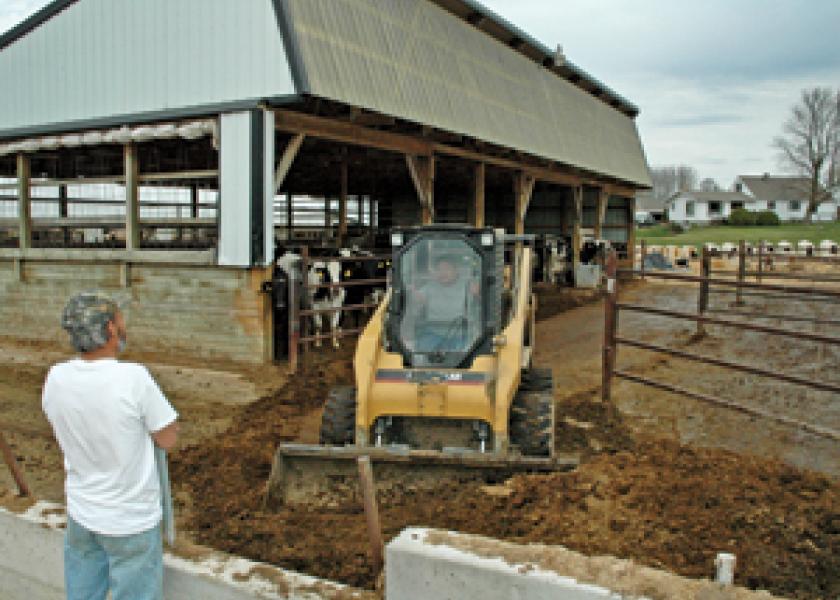OSHA On-Site!

Wisconsin dairies in forefront of safety inspections
Twelve Wisconsin dairies have been targeted by the Occupational Safety and Health Administration (OSHA) as part of the agency’s Local Emphasis Program for dairy farm operations.
Inspections are being done to ensure that dairies with more than 10 nonfamily employees are in compliance with federal safety regulations. A handful have been completed, and the remainder will be done by Sept. 30. The inspections focus on common safety and health hazards and will serve as a benchmark to determine if more inspections are warranted in Wisconsin and other dairy states, says Mark Knezovich of OSHA’s Directorate of Enforcement Programs, based in Chicago.
|
|
While farms selected for inspection might view themselves as unlucky, there are some benefits, says Tom Drendel, an agricultural safety specialist with the National Farm Medicine Center in Marshfield, Wis.
"Compliance with safety rules leads to a decrease in the extent and severity of worker injuries," he says. Having a culture of safety also increases worker morale and productivity and decreases workers’ compensation premiums.
OSHA is currently conducting the program only in its Region 5, which encompasses Illinois, Indiana, Michigan, Minnesota, Ohio and Wisconsin. If patterns of safety concerns are found, inspections of more dairy farms in Region 5 could come next year.
Violations are subject to fines ($100 to $7,000) and abatement periods. "OSHA is not interested in putting small businesses out of business," Knezovich says.
The health and safety of farm workers has caught the attention of federal officials as dairy farms have grown larger and become more reliant on nonfamily labor. There has been a work-related fatality on Wisconsin farms in five of the last six years:
- June 28, 2006. A 32-year-old worker was ejected from and pinned by a skid steer loader.
- Jan. 10, 2007. A self-employed HVAC contractor fell 15' from an unrailed mezzanine.
- Oct. 26, 2009. A 31-year-old worker drowned when he was trapped in the cab of a skid steer that was driven off an unguarded manure ramp into a lagoon.
- Nov. 28, 2010. A 17-year-old worker was crushed against a gate in an animal crowding area while cows were being herded to a milking parlor.
- Feb. 25, 2011. A 23-year-old employee was trampled by a bull while herding cows to the parlor.
OSHA selected three farms from each of its four regional offices in Wisconsin for inspection. Two farms in each region were randomly selected from the state’s list of licensed dairy farms; one farm in each region came from a list of concentrated animal feeding operations with 700 or more cows.
Inspectors are homing in on the following 12 areas:
- Manure storage: Safety stops at manure push-off ramps; warning signs and restrictions such as fencing to prevent entry into lagoons.
- Animal behavior: Training of workers in animal handling and in positioning, avoidance and escape.
- Electrical systems: Absence of electrocution and shock hazards; proper maintenance of systems.
- Skid steers: Training in operations and maintenance; use of approved lift arm support devices during service; no intentional bypassing of safety features.
- Tractor operations: Training in operations and maintenance; rollover protection in place.
- Power-take-off guards: All guards in place.
- Guarding of other power transmission and functional components: All guards in place.
- Safe equipment maintenance: Control of the movement of equipment and parts when servicing equipment, such as blocking tires.
- Hazard communication: Display or ready access to Material Safety Data Sheets for hazardous chemicals such as teat tip, hoof care products and sanitation products, along with training. While OSHA does not regulate pesticides, it forwards any violations of pesticide regulations to the Environmental Protection Agency.
- Confined spaces: Training and safety equipment for entering manure storage vessels; maintenance of manure collection pits and grain bins.
- Horizontal bunkers: Training in removal of feed from bunker silos and removal of silo covers.
- Noise: Adequate hearing protection. An environment is defined as noisy if there is more than 85 decibels for eight hours.
 |
| OSHA inspectors are looking for documentation that workers have been trained in proper cow handling. |
While most farms consider themselves to be safe work environments, every farm can make improvements, Drendel says. Prior to joining the National Farm Medicine Center, Drendel worked at the University of Wisconsin’s Marshfield Agricultural Research Station, in part as the station’s safety officer. State inspectors found more than 40 violations at the station, mostly related to missing guards and electrical plates. Drendel points out that every workplace, even a buttoned-down university facility that preaches safety, needs to make safety compliance part of the daily work routine.
Although OSHA is inspecting just 12 farms in Wisconsin, it has the authority to conduct inspections at any time on farms with more than 10 employees. Inspections can be triggered by reports of an imminent danger, a fatality or safety complaints, Knezovich says. Farms, like all businesses, are required to report workplace fatalities to OSHA.
OSHA does not have inspection authority on a farm if an immediate family member is killed. "But if the farm has more than 10 employees, we might still look at its safety and health programs to ensure those employees are protected," Knezovich says.







